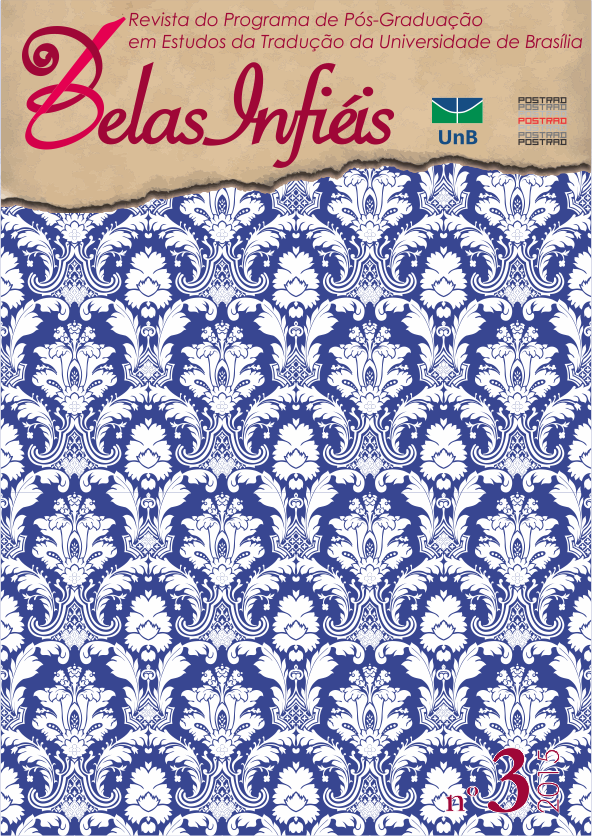ANALISANDO PADRÕES DE COLOCADOS COMO TRAÇOS DO ESTILO DA TRADUÇÃO:
UM ESTUDO DE CORPUS PARALELO A PARTIR DE UMA TRADUÇÃO ESPANHOLA E UMA TRADUÇÃO PORTUGUESA DE HEART OF DARKNESS
DOI:
https://doi.org/10.26512/belasinfieis.v4.n3.2015.11349Palabras clave:
Estilo, corpora paralelos, ETBC ”“ Estudos da Tradução Baseados em Corpus, Heart of DarknessResumen
Neste estudo exploratório descreve-se o estilo de duas traduções de Heart of Darkness (CONRAD, 1902), uma espanhola (FOLCH, 2007) e uma do português europeu (RODRIGUES, 2009), usando um corpus paralelo. O estudo tem como aporte teórico os estudos de estilo da tradução e utiliza a metodologia dos Estudos da Tradução Baseados em Corpus ”“ ETBC. Toma-se como base Stubbs (2003, 2005), que defende o uso de informações quantitativas para um estudo mais detalhado da obra de Conrad. Stubbs (2003, 2005) afirma que um dos temas principais da obra de Conrad é realizado pela repetição de itens lexicais que denotam incerteza e impressões vagas, especialmente pelo uso elevado do lema seem* (79). Stubbs (2005) chama atenção para o fato de que o lema seem*, que não é comumente um verbo de frequência alta em textos ficcionais, está entre os 10 verbos mais frequentes na obra. Investigando-se a alta frequência do lema parec* nos dois textos traduzidos (TTs) referidos verificou-se que em Folch (2007) a frequência é maior (111) em relação ao texto fonte (TF), pois se observa que o tradutor utilizou essa forma para a tradução de outros itens que não aqueles derivados do lema seem*. Rodrigues (2009) apresenta uma frequência um pouco maior do lema parec* (126) e realiza 15 escolhas diferentes para a tradução dos itens lexicais derivados de seem*. Com base nesses dados, procura-se descrever as mudanças significativas que ocorreram no estilo dos textos traduzidos com relação ao uso do verbo parecer.
Descargas
Citas
Corpora de estudo
CONRAD, J, 1902. Heart of Darkness. Londres: Penguin Books, 1902/1994.
_________, J. El Corazón de las tinieblas. Tradução de Borja Folch. Barcelona, Espanha: Ediciones B, S.A, 2007. 144 p.
_________, J. O coração das trevas. Alfragide: Dom Quixote, 2009 (Tradução de Fernanda Pinto Rodrigues).
Corpora de referência
Corpus de referência do espanhol disponível em: http://www.corpusdelespanol.org. Acesso em 22/03/2015.
Corpus de referência do português europeu disponível em http://www.linguateca.pt/. Acesso em 22/03/2015.
Corpus de referência do inglês disponível em http://corpus.byu.edu/bnc/.Acesso em 22/03/2015.
Referencial teórico
BAKER, M. Towards a methodology for investigating the style of a literary translator. Target, Amsterdam, v. 12, no. 2, 2000. p. 241-266.
MALMKJAER, K. What happened to God and the angels: an exercise in translational stylistics. Target, Amsterdam, v. 15, 2003. p. 37-58.
MALMKJAER, K. Translational stylistics: Dulcken‘s translations of Hans Christian Andersen. Language and Literature. SAGE publications (London, Thousand Oaks, CA and New Delhi), v. 13 (1), 2004. p. 13-24.
MUNDAY, J. Style and Ideology in Translation: LatinAmerican Writing in English. New York: Routledge, 2008. 261 p.
SALDANHA, G. Translator Style: methodological considerations, Manchester: St. Jerome Publishing, The Translator. Volume 17, Número 1, 2011. p. 25-50.
SINCLAIR, J. Corpus, concordance, collocation. New York: Oxford University Press, 1991. 179 p.
SINCLAIR, J. Trust the text: Language, corpus and discourse. London: Routledge, 2004. 211 p.
STUBBS, M. Conrad in the computer: examples of quantitative stylistic methods. Conrad, Concordance, Collocation: Heart of Darkness or light at the end of the tunnel? Language andLiterature. Trier, Alemanha: Universidade de Birmingham: 14, 1, 2003. p. 5-24.
STUBBS, M. Conrad in the computer: examples of quantitative stylistic methods. Language and Literature. Volume 14, Número 5, 2005. Disponível em:http://lal.sagepub.com/cgi/content/abstract/14/1/5.
Descargas
Publicado
Cómo citar
Número
Sección
Licencia
Copyright Statement
Given the public access to this journal, the texts are free to use but requires the recognition of the original authorship and initial publication in this journal to be properly stated.
The journal allows the use of works published for non-commercial purposes, including the right to submit the work to publicly accessible databases. Published contributions are the sole and exclusive responsibility of the author(s).
- When submitting papers to be evaluated by the Belas Infiéis journal, the author(s):
- Declare that the contents of the contributions are original and of their original creation, being entirely responsible for their content if there is an objection by third parties.
- Claim to be aware that they should not commit academic plagiarism.
- Declare that the manuscript has not been published, completely or partially, in Portuguese or another language. If it is a translation it should be submitted to the Translated Articles section.
- Declare that the manuscript is not being evaluated by other journals.
- Declare that the manuscript was not submitted to another journal simultaneously.
- Commit(s) to inform the journal of any kind of error or inaccuracy in their contribution (published, in evaluation or in editing) and to collaborate with the editors to make due corrections of the article (when in evaluation or editing) or erratum/retraction (after publication).
- Declare that there is no conflict of interest regarding the published work.
- Authorize its release if it is accepted for publication without any kind of monetary compensation.
- Agree to assign non-exclusive rights to publication to the magazine, remaining free to make their contribution available in other media as long as the publication of the first version in Belas Infiéis magazine is mentioned. They also authorize Belas Infiéis to assign their texts for reproduction in content indexers, virtual libraries and similar platforms.
- Maintain copyright and grant the journal the right of first publication, the work being licensed under theCreative Commons Attribution License.
- Is/Are allowed and encouraged to publish and distribute their work online after the editorial process, which may increase the impact and citation of the published work.
- Authorize the editorial team to make textual adjustments and to adapt the article to the publication rules, when necessary.



















